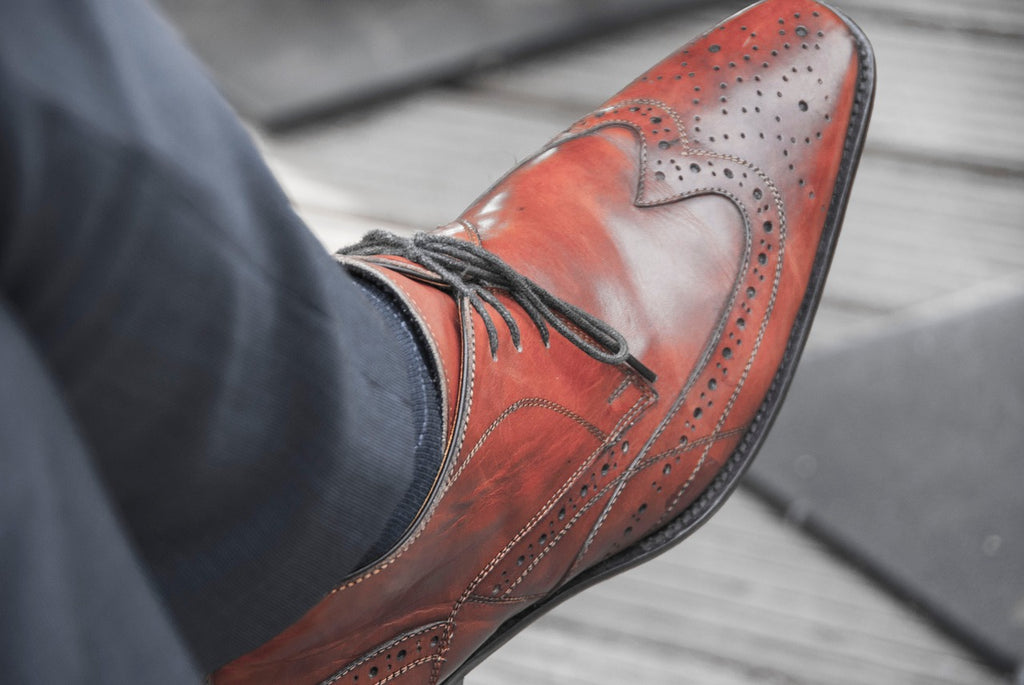How Men's Dress Pants Should Fit

Ever put on a pair of dress pants and wonder to yourself, “is this how they’re supposed to feel?” If so, you’re one of many men who aren’t quite sure how dress pants should fit. Should they be tight and snug? Loose enough to allow you to sit comfortably? Just how tight should it be around the waist, and how much fabric should extend over the ankle?
Let’s answer those questions. Here’s how men’s dress pants should fit.
How Pants Should Fit in the Back
One of the most telling signs of an ill-fitting pair of trousers is how they look in the back. Also known as “the seat,” this is the area of your pants under the back waist and ending at the top of the legs. In other words: your bottom.
- If the trousers are too tight, you’ll notice “squeezing” underneath your bottom. The waist will look taut and you’ll notice horizontal lines at the tops of the legs.
- If the trousers are too big, you’ll see the opposite: billowing, especially with more vertical lines. You’ll have plenty of extra fabric you can grab in the back.
When the trousers fit properly, you should be able to turn around in the mirror comfortably, noticing that there’s minimal “bunching” and “billowing.” The bottom line is that your pants shouldn’t have too many wrinkles caused by tightness or looseness. Instead, they should fall naturally from your bottom, extending down the leg comfortably.
How Pants Should Fall on the Ankle

Your pants may feel good when it comes to the bottom, but what about their literal bottom—where the hem falls on the ankle? This is known as the “trouser break,” and there are a few key things you should look for:
- If your pants are too long, the trouser break will wrinkle as it sits above your shoe. If you notice that the bottom hem of your trousers bends excessively, then you’ll need less fabric.
- If your pants are too short, then you’ll notice no bending at all. Instead, the pants will pull away from the ankle and reveal far too much of your socks. If you have to err on either side, it’s better to err on the side of too short—however, there’s a middle ground you should look for as well.
- Properly-fitting trousers will strike the top of your shoe, covering most of your sock—without the excessive bending and wrinkling associated with pants that are too long.
Bottom line? If there’s anything more than one slight indentation where your trouser meets the ankle, think about sizing down.
How Pants Should Feel at the Waist
The waist of your pants is probably the easiest to determine. You should be able to wear your trousers without a belt, with the pants still fitting comfortably around your waist. If they fall down without a belt, they’re too large. If they’re too tight and uncomfortable, go up a size. It’s tempting to allow the belt to fix these issues, but keep in mind that the belt is also an accessory. It’s not designed to make up for shortcomings when it comes to fit.
Be Careful with the Big-Brand Size Charts

When Esquire did a study of how large the big brands’ pants actually were (as compared to how large they’re advertised), there were some major discrepancies. “36 inches” became 37”—one brand even had them as large as 41”. In the clothing industry, this practice is called “vanity sizing,” because it makes people think they’re trimmer than they actually are.
How can you tell which is which? At Berle, we make a point of offering tailored trousers that feature more than just one size. Look for trouser companies that give you specific numbers for specific measurements, not “Medium” and “Large.” The more precise fit is more likely to give you the comfort you need along with the tailored look your trousers need.But if you want a good fit, accuracy is important. That’s one reason to stay away from the big-name brands and stick with a company that pays attention to precise tailoring.
Get the Bottom Right
One of the first places you can look to tell if pants don’t fit? The bottom. Your trousers should just hit the top of your shoes without piling up over your laces. They shouldn’t be too short, either—which means they shouldn’t show off too much sock when you’re standing up.
Hitting this perfect balance is a matter of getting the inseam to be the right number. You can measure the inseam of your favorite pants to have an idea of what this number might be for you. You can also rely on our complimentary hemming to ensure that even if you order trousers that are too long, you’ll end up with something that strikes the shoe just right.
Consider Tailored Trousers From Berle

Want to make sure that your next pair of men’s dress pants fit you properly? Browse the Berle Tailored Trousers Collection and enter in your personal measurements to get a proper fit the first time!
Tailored Trousers
Featured Pieces




